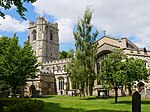Luton ( ) is a town and unitary authority with borough status in Bedfordshire, England, with a population at the 2021 census of 225,262.The town is on the River Lea, 30 miles (50 km) north-west of London, 18 miles (29 km) north-west of Hertford, 20 miles (32 km) south of Bedford and 22.5 miles (36.2 km) south-east of Milton Keynes. The town's foundation dates to the sixth century as a Saxon settlement on the river, from which Luton derives its name. Luton is recorded in the Domesday Book as Loitone and Lintone. One of the largest churches in Bedfordshire, St Mary's Church, was built in the 12th century. There are local museums which explore Luton's history in Wardown Park and Stockwood Park.Luton was once known for hatmaking and also had a large Vauxhall Motors factory. Car production at the plant began in 1905 and continued until its closure in 2002. Production of commercial vehicles continues and the head office of Vauxhall Motors is in the village of Chalton on the northern border of the borough . London Luton Airport opened in 1938 and is now one of Britain's major airports, with three railway stations also in the town. The University of Bedfordshire was created from a merger with the University of Luton; two of its campuses are in Luton.Luton Town Football Club, nicknamed the Hatters, due to the town's connection to hatmaking, has had several spells in the top flight of the English league as well as a Football League Cup triumph in 1988. They play at Kenilworth Road, their home since 1905; planning permission for a new larger stadium was approved in 2019. Luton International Carnival, the largest one-day carnival in Europe, is held on the day before the last Monday in May; the Saint Patrick's festival is held on the weekend nearest to Saint Patrick's Day as there is a large Irish community in Luton. The town also has a large Pakistani community which, along with the Irish, were attracted to employment at the Vauxhall car plant. Luton Hoo is an English country house, estate and Grade I listed building originally designed by Scottish architect Robert Adam but later transformed to the designs of Robert Smirke.




